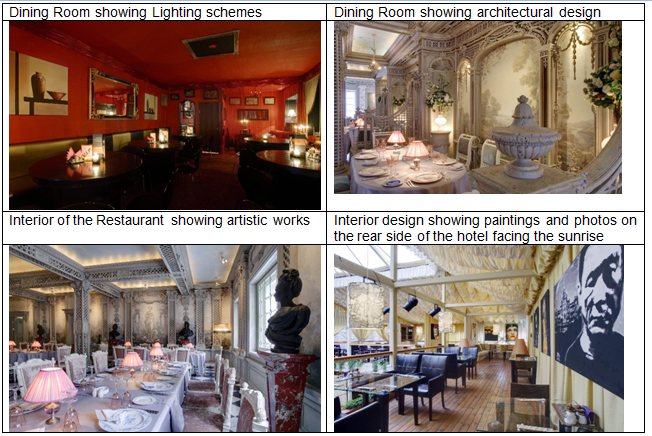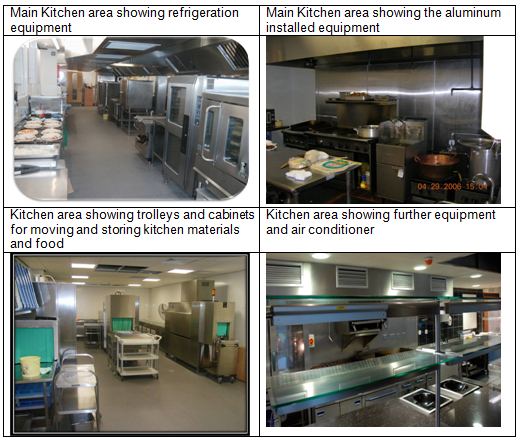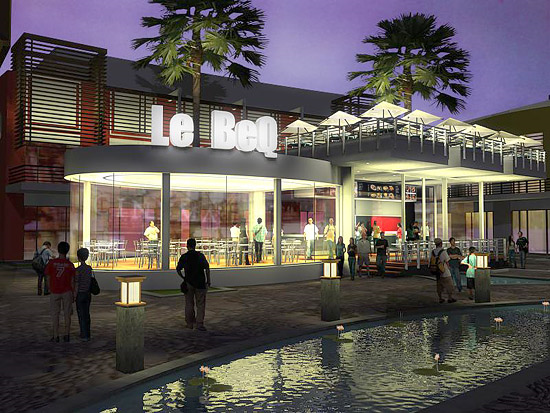Introduction
Servicescape in its simplest form is a concept that defines how physical surroundings can influence and affect people and events within the vicinity.
Having been a concept that was first suggested by Booms and Bitner, it has gained popularity based on their original definition which they gave as: “the environment in which the service is assembled and in which the seller and customer interact, combined with tangible commodities that facilitate performance or communication of the service” (Bitner and Booms, 1981, p. 36).
It has many enabling concepts that are in line with its core intent in corporate development and that is why servicescape is among the most prosperous business concepts that finds universal appreciation and application. This paper in discussing this topic uses pop-up restaurants and pop-up or flash retailing event as one of the latest trends in the experience economy.
This will be done by considering an event and design of a restaurant, Metricum Restaurant, that will attract young people to the display of the restaurant’s design exhibition and in the process realize profitability for the owner of the building where the two week event will be hosted.
Design of the Restaurant
The design is given in three regards: the interior, the exterior and the kitchen area. These areas reveal the personality, brand and concept of this pop-up restaurant that creates a memorable impression of guests and clients. Metricum Restaurant has an instant curb appeal which is seen by well-lit areas at its entry with well done landscaping fully glowing with its name at the main entrance.
In the interior, the restaurant is painted with archaic paints that communicate its concept of antediluvian sophistication. Its walls are furnished with sparkling beige varnish that shines straight from the main entrance.
The main lounge of the hotel is lit with yellow and orange tones that create a warm environment (Ton, Bijman and Oorthuizen 2007). There is a dining room which is dimly lit with round tables lined with marched candles to create a romantic feeling.
These designs greatly increase its architectural and interior elements. In order to furnish the restaurant further, the walls and selected areas are designed specially with murals, paintings, sculptures and mounted and these complement the areas’ colour themes and supports the personality of the restaurant’s brand (Ton, Bijman and Oorthuizen 2007). The following photos show different aspects of the hotels interior design.

The kitchen design of the restaurant is equally finely furnished with marble walls and tiles on the floor. It has melamine trolleys by which food and other bulky products are moved around the kitchen into the serving/ordering area. The cookers and steamers are made of shiny aluminum and the cooking utensils as well of the cutlery are made of stainless steel.
The walls are decorated with artwork and to extreme rear of the kitchen; there is a giant air conditioner to moderate the temperatures in the cooking area. The following photos show different areas of the main kitchen area of the hotel. These designs have been done to ensure good space for the working staff and installation of equipment as well, takes of flooring, lighting and ventilation (Diane 2004, p. 105).

The exterior design of the restaurant reflects the environment where it is found and to reflect this, the hotel has been designed to have the trendy sophistication required to appeal to its potential customers. Its ventilation sideways is made of well furnished wood with walled glassware occupying the main entrance into the reception.
There is a well finished pool surrounded with earthen marbles tan in colour to match the tan asbestos roof. There is a marble lined curb with gutters on either side lined with rectangular housed sodium vapor lamps to give the calm evening touch when they gracefully glow at night. The figure below shows the restaurant’s exterior design.

Promotion Strategy
The theme of this pop-up event for which a promotion strategy is desired to be part of a high end retail and pop up restaurant for a two week event which should be an experience that allows young designers and artisans to producers of different fields to showcase and sell their wares under one roof.
The event is intended to attract the attention of professionals within the range of 21 to 35 years and in doing so the event has two foci: the pop up retail event itself and then the retail event as a means for the property developer to launch the refurbished factory space into apartments for sale off the plans. The trading hours will be 11 am to 10 pm, Wednesday to Sunday for two weeks in spring of 2011 (Dixon 2005).
This event will be a prime opportunity for artisans of different cadres to come and show case their talent and therefore has its main objective as sensitizing its audience about the beauty of artistic work to persuade them into admiring and eventually appreciating their design work. The presentation will be done in the old factory building where the Metricum Restaurant will be set up as per the designs aforementioned and presented.
The justification for this objective is that for every business endeavour, the single reason that informs investment is realization of profits and growth of the market share of the company trading in the product fronted in the market (Borden 2001).
This therefore means that an presentation strategy should be steered towards ensuring that there is adequate profitability that can be derived from the event and in so doing also ensure that there is adequate market share that the event helps the company to attain in its niche market (Warnaby, Bennison and Davies 2005).
This objective is also informed by the need to have the building attain a considerable media attention that once the event is over and the building is furnished into executive apartments, the owner will have had the privilege of sufficient media attention to boast its sale to interested buyers (Diane 2004, p. 105).
Strategies for each element of the marketing mix
Objectives of the event
- The function of the event will be such that it meets consumer needs and satisfies them with its convenience and effectiveness.
- To ensure consumer satisfaction, the appearance of the event in presentation will be such that its artistic and aesthetic value is unrivalled.
- To further consolidate the event’s likeability in the market, the ease of using, portability and participation will be enhanced with the most recent Food Science technologies.
Objectives for the Distribution Approach
- It will be the intention of this promotion strategy to limit the extortion of middlemen as much as possible by facilitating distribution channels that reach the consumers directly as far as it is possible.
- Distribution will be skewed so as to take advantage of the company’s popularity in the market by making its market coverage as extensive as possible reaching to individual households as well as corporate businesses that form part of the target market.
- To improve logistics and level of service in the distribution channels, for anything relating to the event will be merchandised in physical stores as well as virtual stores on the internet (Hughes and Merton 1996).
Objectives of the Promotion Approach
- Advertising to popularize the event in addition to educating consumers on the advantages of attending this event within the market will be done.
- There will be deliberate efforts done in public relations to foster acceptance and usage of the event within the market.
- Given the high costs of promotion, break-even analysis to determine the value of consumer in order to determine whether additional customers are worth the cost of acquiring them will be done before engaging in these promotional activities.
I find these the best strategies for the mix that will help realize the objectives of the plan. This is so in three broad fronts. First, the broad spectrum in which the strategies permeate in the marketing elements from competitor’s influence to market forces make them representative in their consideration of the factors that could affect the company’s venture with the event (Wright and McCrea 2007).
Secondly, these strategies are incorporative of the company’s strengths and weaknesses in a way that gauges the company’s comparative advantage in its niche market and therefore give it a better approach in its market entry with the event to ensure profitability; a core objective for the company with the event.
The strategies for the mix further afford for flexibility in the target market so as to broaden its scope of acceptance while at the same time remaining consistent with the company objectives and mission (Gilbreath 2009).
Conclusion
Methods to Measure the success of the event
Methods of measuring the success of the event will be analyzed under two methods: by use of post-event feedback from various selected people and by a check list that will be considered during the Events Management Committee evaluation meeting after the event.
There will be questionnaires for the attendants to indicate their satisfaction and these questionnaires will contain sentiments from the attendees and will be analyzed during the evaluation meeting of the events Management committee meeting three days after the event. Portions that will be of importance in determining the success of the event will those that relate to the following areas:
- Whether all outstanding dues were serviced in time in accordance with the budget (Jeston 2009).
- Whether all the invited guests made it to the event
- Whether refreshments and snacks served in the course of the event were enough
- Whether the day’s program was followed and time well managed
- Whether the event began and was concluded at the correct time according to the set out program (Jeston 2009).
This preparedness for this launch is aimed at using this event to create relationships between the company and various guests in attendance (Leigh and Waddock 2006, p. 406). To help realize this, the event will be promoted using contemporary hotel web-site that will be designed specifically for this job.
Another promotional tool that will be used will be releasing press statements to the Culture Section of London’s most distinguished newspapers (Thompson and Martin 2005, p. 34). The website created for promoting the event will also be used to provide audience feedback where it will be designed to have an interface that allows people to log in and leave their comments and thoughts about the events of the Launch.
Reference List
Bitner, J. and Booms, B., 1981. Marketing Strategies and Organizational Structures for Service Firms. Chicago: America Marketing Association.
Borden, N., 2001. The Concept of the Marketing Mix. Journal of Advertising Research, 4(1), pp. 2-7.
Diane, T., 2004. Our Heritage: Company Chronology: PATCHI Shops. Washington: Diane Publishing.
Dixon, T.J., 2005. The Role of Retailing in Urban Regeneration. Local Economy, 20(2), pp. 168-182.
Gilbreath, B., 2009.The Next Evolution of Marketing: Connect with Your Customers by Marketing with Meaning. 1st ed. New York, N.Y.: McGraw-Hill.
Hughes, D. and Merton, I., 1996. Partnership in Produce: The J Sainsbury Approach to Managing the Fresh Produce Supply Chain. Supply Chain Management: An International Journal, 1(2), pp. 4–6.
Jeston, J.C., 2009. Beyond Business Process Improvement, on to Business Transformation: A Manager’s Guide. Tampa: Meghan-Kiffer Press.
Leigh, J. and Waddock, S., 2006. The Emergence of Total Responsibility Management Systems: J. Sainsbury’s (Plc) Voluntary Responsibility Management Systems for Global Food Retail Supply Chains. Business and Society Review, 111(2), pp. 409–426.
Thompson, J.L. and Martin, F., 2005. Strategic Management: Awareness and Change. New York: Cengage Learning EMEA.
Ton, G., Bijman, J. and Oorthuizen, J., 2007. Producer Organizations and Market Chains: Facilitating Trajectories of Change in Developing Countries. Wageningen: Academic Publishers.
Warnaby, G., Bennison, D. and Davies, B.J., 2005. Retailing and the Marketing of Urban Places: A UK Perspective. International Review of Retail, Distribution and Consumer Research, 15(2), pp. 191-215.
Wright, S. and McCrea, D., 2007. The Handbook of Organic and Fair Trade Food Marketing. Oxford: Wiley-Blackwell.